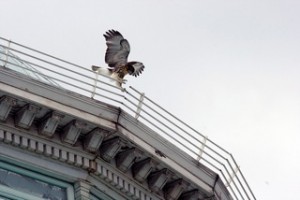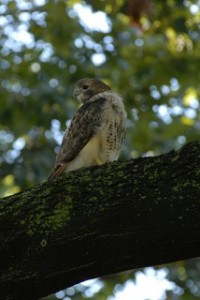Life on the Ledge: Red-Tailed Hawks at the NYBG
Posted in Adult Education, Around the Garden, Learning Experiences, Photography, Wildlife on March 15 2012, by Joyce Newman
Joyce H. Newman is the editor of Consumer Reports’ GreenerChoices.org, and has been a Garden Tour Guide with The New York Botanical Garden for the past six years.
 Walking by the NYBG Library Building yesterday, we spotted a huge Red-tailed Hawk as it swooped across the trees and sailed to the top of a giant oak. During the daytime, these hawks are the top avian predators in our area and very impressive to behold (at night, the Great-horned Owls reign supreme). A group of bird watchers on the path gazed upward with large binoculars and telescopes.
Walking by the NYBG Library Building yesterday, we spotted a huge Red-tailed Hawk as it swooped across the trees and sailed to the top of a giant oak. During the daytime, these hawks are the top avian predators in our area and very impressive to behold (at night, the Great-horned Owls reign supreme). A group of bird watchers on the path gazed upward with large binoculars and telescopes.
Maybe this bird is a distant cousin of Pale Male, the famous Red-tailed Hawk who settled in Manhattan in the 1990s, defying hazardous urban living conditions and continuing to produce young hawks to this day. Or it could be a cousin of last year’s celebrity Red-tailed Hawk, Violet, who enchanted the residents of Washington Square Park in Manhattan before succumbing to a heart condition. Or perhaps it is one of the Garden’s own celebrity hawks, Rose and Vince, or one of their many, many offspring.
 Violet, a new mother with an injured leg, took care of her baby despite dire predictions. Her nest was monitored last year by the New York Times‘ “Hawk Cam” mounted at the 12th-floor window of Bobst Library, just outside the New York University president’s office. Recently a new hawk couple, Bobby and Rosie, settled into the NYU ledge and excitement is mounting as there are already two eggs in the nest! The Times’ Hawk Cam has been re-activated to document the unfolding drama.
Violet, a new mother with an injured leg, took care of her baby despite dire predictions. Her nest was monitored last year by the New York Times‘ “Hawk Cam” mounted at the 12th-floor window of Bobst Library, just outside the New York University president’s office. Recently a new hawk couple, Bobby and Rosie, settled into the NYU ledge and excitement is mounting as there are already two eggs in the nest! The Times’ Hawk Cam has been re-activated to document the unfolding drama.
Our Red-tailed Hawk at the NYBG is one of possibly a half-dozen that have been sighted lately, based on reports from local wildlife photographers and our own staff. In the past, Rose originally nested on the Library’s ledge in 2009 with her original mate, Hawkeye. And there has definitely been activity on the Library Building nest again this year, as documented by NYBG Member and avid amateur wildlife photographer Patricia Gonzalez. But word also comes from Fordham professor Richard Fleisher that Rose and her current mate, Vince, have been spotted shoring up the nest at Fordham, too. And so the mysteries continue: Is there a nest at NYBG? Is it Rose and Vince? Or is it some of their offspring?
The Garden is an incredible place to watch all birds, not just hawks and owls, and with spring seemingly setting in early, it’s time to start seeing some of the northeast’s most interesting migrants. To learn more about bird watching at the NYBG, as well as the natural habitats of our native birds and how to photograph them, check out the three “birding” classes being offered this April.
Bird Watching in New York City — Starting on Saturday, April 14 at 10 a.m.
Even if you’re not that into Red-tailed Hawks, there are hundreds of bird species that pass through the New York City area, says instructor Bradley Klein, an urban naturalist. His class explores a new location each week, including the NYBG’s 50-acre forest, Brooklyn’s Jamaica Bay, and Central Park. The first session is held at the Garden followed by two field trips accessible by public transportation.
Natural Habitats for Native Birds — Starting on Saturday, April 14 at 1:30 p.m.
Find out why birds use particular trees, shrubs, and other plants as food sources and nesting sites. Then plan how to attract birds to your own garden. Instructor Debbie Becker has been leading bird-watching walks at the NYBG for 25 years. Watch her video for more information.
Photographing Birds: Workshop — Starting on Sunday, April 15 at 11 a.m.
Because birds move quickly and unpredictably, they can be difficult to photograph. But instructor Debbie Becker knows the professional techniques that will help ensure high quality images.


Nicely-written, Joyce. The NYBG hawks are better than any daytime soap opera! It’s always a blast shooting them (or trying to). They can certainly work one’s lenses trying to capture their images. : )